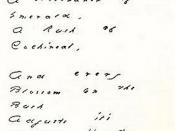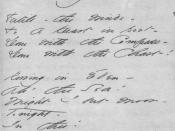As Jay Ladin noted in his article, "Breaking the Line: Emily Dickinson and William Carlos Williams," the line breaks function as "a heightening of concentration, a redirection of attention from larger units . . .to smaller units, phrases, [or] words . . ." (42). For example, in the first two stanzas, the separation of "it seemed" and "I thought" onto their own lines emphasizes the subjectivity of the speaker's experience. The line breaks here also draw the reader's eye to the repetition of "Kept treading" and "Kept beating." The violent downward motion of the action is heightened by the lineation in last stanza. The dashes function comparably to separate and highlight particular phrases and, like the breaks, force the reader to pause and confront the meaning of the word or phrase before proceeding. The dash between "Space" and "began to Toll" functions this way. The dashes at the end of lines also work to question the finality of the line in a way that a period cannot.
Ladin sees the dashes as performing another crucial component of Dickinson's collaborative philosophy, since they ask "readers to substitute mentally appropriate punctuation," without having to chose a particular one consistently (44). Thus, unlike Todd and Higginson's period or comma, the reader can decide whether to close the phrase or merely pause.
Reinserting the "+"s with the variant words similarly offers readers a choice without stipulating either which to choose or even that a particular option must be chosen. Visually, the placement of a "+" in the text alerts the reader that the choice exists, rather than, like Johnson, acknowledging the variation outside the boundaries of the poem as an aside. Finally, the inclusion of a crossed out word, "Brain," is more than just an faithful rendering of the handwritten work. Rather than assume, as Johnson does, that some poems are more finalized than others, I would rather allow the reader to conjecture whether the word has a function in the poem. For me, it offers a unique opportunity to speculate not only on what "Soul" signifies, especially since it is emphasized and differentiated by its own line and capitalization, but also what meaning it has that "Brain" does not.
In conclusion, I have produced my version of Dickinson's poem "I felt a Funeral" as a direct invitation to the reader to participate in her interpretation of the poem without directing her views with editorial comments like changing a dash to a comma, un-capitalizing a key word, or regularizing a line break. My discussion of the importance of Dickinson's punctuation, capitalization, and stanzaic pattern hopefully have not imposed a particular meaning on the poem. Essays which do encourage particular interpretations of the poem are included under "For Further Readings," as are other essays on Dickinson's innovative style.





